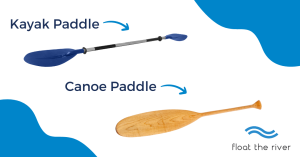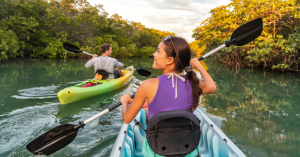Kayaking or Canoeing: Which One Should You Choose for Your Next Outdoor Adventure?
Whether you’re floating carelessly down a river or navigating fun, choppy waters, kayaking or canoeing are the perfect ways to connect with nature, relax, or simply enjoy being alive and pumping up that adrenaline.
Of course, how to go about the process regarding which one is best, a kayak or canoe, is up for debate, with many opinions on either side. Therefore, we have compiled this helpful information to share everything you need to know about kayaking and canoeing, how they differ, and which option is best suited to your purposes.

Table of Contents
- What Are the Main Differences Between Kayaking and Canoeing?
- Are Kayaks More Stable Than Canoes?
- Is Canoeing Easier Than Kayaking?
- What’s the Difference in Gear?
- What Are the Safety Considerations?
- What Are the Health Benefits of Kayaking vs. Canoeing?
- Which Is the Better Option for Families or Groups?
- So, Which One Should I Choose?
What Are the Main Differences Between Kayaking and Canoeing?
The primary differences between a kayak and a canoe can be found in the vessel’s shape, which includes the hull, seat, and cockpit area.
Canoes are generally open-top; you can sit on a bench or kneel when operating them in an elevated position. Canoes also tend to sit higher in the water.
On the other hand, Kayaks often have a closed deck with a hole cut out in the middle for you to sit down on the seat, or they can be designed for you to sit atop them. Either way, kayaks have a lower profile, meaning they sit closer to the water.
The difference in how they are situated in the water will significantly alter paddling techniques and other elements, such as stability.

Are Kayaks More Stable Than Canoes?
While both vessels’ stability depends on many elements, including overall design, size, and more, canoes are typically more stable than kayaks. It’s worth noting, however, that the recreational versions of kayaks and canoes are usually pretty stable.
However, depending on the waters you will be navigating, whether rough or calm, the vessel’s stability will significantly affect the type of boat you want. For example, canoes are ideal for tranquil waters but aren’t nearly as good at navigating choppy waters with obstacles.
Is Canoeing Easier Than Kayaking?
While either option can benefit beginners, you might feel more qualified to attempt canoeing without a lesson.
However, both options can be challenging to master, requiring instruction, learning skills, and balance to conquer and perfect your technique. Therefore, generally, they are equally applicable to beginners just starting.
Both canoeing and kayaking are considered very similar to riding a bike in that they require perfecting a certain amount of balance and technique. Still, once you master those elements, you can build on them quickly to improve your efficiency.
What’s the Difference in Gear?
The gear differs slightly between kayaks and canoes.
Kayaks use double-bladed paddles. You use twisting and alternate sides to paddle a kayak for more efficient paddling. It is a whole-body technique requiring more than just your arms.
For a canoe, you use a single-bladed paddle and move from one side to the other to keep the canoe heading straight ahead. It is a much less twisting motion when compared with paddling a kayak, but it still utilizes the legs and torso.
Paddles are essential, as they act as your motor in the water, ensuring you get the right fit for your vessel and intended purpose. While plastic blades are durable and affordable, fiberglass versions are lighter. Carrying extras is always a good idea, as you never know when you will lose a paddle. Of course, you should wear a life jacket when operating a kayak or canoe.

What Are the Safety Considerations?
Safety considerations are essential, as with any watercraft in a river or water.
Canoes tend to be broader and more stable and do not flip as quickly. However, kayaks, as they are steered with double-bladed paddles, can be easier to navigate and control.
The primary safety considerations include staying in the boat and not dealing with a capsize situation if your boat turns over. If you flip your kayak or canoe, pull the vessel to the side of the water and then attempt to flip it back over, removing any accumulated water.
The fact that either of these vessels can flip makes it much more vital to wear a flotation device or life jacket and other items, such as your phone, in a waterproof container.
It’s also a good idea to know how to swim. Although you should be wearing a flotation device, in the unlikely event that you lose it, it’s important to know how to swim and keep yourself safe.
You never know what will happen; even when you are careful, you can end up unexpectedly in the water. For this reason and more, it’s also a good idea to always boat with someone or, at the very least, let someone know your intended float plan.
What Are the Health Benefits of Kayaking vs. Canoeing?
Operating a kayak or a canoe can improve strength, flexibility, and aerobic fitness. They are fun activities and great ways to stay fit or get fit. They are also both low-impact overall, which makes them ideal to get into as a novice.
Of course, with kayaking, in particular, the intensity can significantly increase if you start competing or increasing the difficulty of the water or obstacles. As your fitness level improves, you can continue to challenge your body with kayaking.
Conversely, canoeing is always a little more leisurely but is still beneficial fitness-wise. Some of the most notable health benefits of kayaking and canoeing include:
- Paddling increases muscle strength, especially in the shoulders, arms, back, and chest.
- Improved cardiovascular fitness.
- Reduced risk of wearing out tissues and joints since they are low-impact activities.
- Increased strength in the legs and torso: the strength to paddle both a canoe and kayak comes from the legs and torso and involves a great deal of body rotation.
- Emotional benefits include a greater sense of well-being. Enjoying a leisurely paddle down a body of water can be a meditative and peaceful experience, improving stress levels and overall emotional well-being.

Which Is the Better Option for Families or Groups?
There are many benefits to both types of vessels for various outdoor activities involving families and groups. The two varieties of sports and the vessel best suited for those particular situations include:
- Fishing: When fishing, it’s all about your intention when choosing a canoe or kayak.
- A canoe is better in calm water, and it allows you to have someone with you if that is your desire, which means group fishing and such are likely better from a canoe.
- However, kayaking offers more versatility when trying to be stealthy and maneuver into specific areas where fish might hide. For a solo fishing trip, kayaks are the better option.
- River Tours: Again, it depends on your purpose when determining which vessel is better suited for this activity.
- If your goal is leisurely floating down a river, slow-paced and easy, then a canoe is likely better, especially if you are not alone.
- However, if the river gets choppy, if you have to navigate around obstacles, or if you would like to boat alone or at least in your vessel with a group, then a kayak is likely the better option.
So, Which One Should I Choose?
Ultimately, the decision to canoe or kayak hinges on your preferences, reason to be active, and where you’re navigating the waters.
From stability to sizes and shapes, skill level, fitness reasons, or required safety precautions, considering all those can help you decide which is best for you.
So, whether you lean towards the rhythm of paddling a canoe or the exhilaration of steering a kayak, your choice between the two symbolizes not a better or worse but celebrates the intrinsic beauty of both watercraft.
Short Trip Kayaking with Float the River
Choosing Float the River for your kayaking adventure on the Cuyahoga River and Cuyahoga Falls promises an unparalleled experience for all levels of enthusiasts. If you’re a beginner, our Cuyahoga Falls Kayak Rental offers the perfect opportunity to test the waters, with short, manageable trips of 45 minutes to an hour and no swift-moving water to worry about.
Our offerings extend from solo to tandem kayaks, ensuring a customized experience whether you’d prefer a solitary sojourn or sharing the experience with a loved one. For a worry-free journey, Float the River has your back. Book your next kayaking trip with us today!
